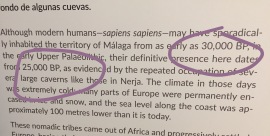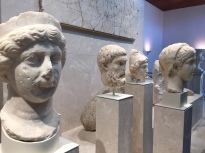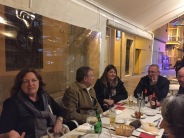I love my friends. And they just know such interesting STUFF!
 We toddled off to the Museo de Málaga last week, my second visit there, this time with a mixed group of British and Spanish. I’m a bit rubbish with museums, usually. Ten minutes, a quick waltz round, and then head for coffee. But this museum is more interesting than most. It benefits from excellent info-panels in Spanish and English, and it has simply fascinating exhibits. Jewellery, stones, pots, tools, statues, mosaics, columns, ranging from artefacts a thousand years old right back to stuff from 30,000 years BP.
We toddled off to the Museo de Málaga last week, my second visit there, this time with a mixed group of British and Spanish. I’m a bit rubbish with museums, usually. Ten minutes, a quick waltz round, and then head for coffee. But this museum is more interesting than most. It benefits from excellent info-panels in Spanish and English, and it has simply fascinating exhibits. Jewellery, stones, pots, tools, statues, mosaics, columns, ranging from artefacts a thousand years old right back to stuff from 30,000 years BP.
Yes, “BP”, not “BC”. The first time I had gone, I’d noticed this abbreviation; apparently back in the second half of the 20th C, geologists, scientists and international carbon-dating experts agreed that for the world-wide scientific community it wasn’t appropriate to use a  date rooted in just one religion, not recognised across the world. So they came up with “BP”: not a petrol company, but an abbreviation for “Before Present”. And in Spanish, “AP” – antes de presente. Now, according to the archaeologists, “present” means January 1st, 1950! However this discrepancy isn’t terribly important, as if a museum item dates from, say, 1865, they will put the date. Or 1792. Because in those cases the actual year is known. However, once it gets to more than about 3,000 old, they will put 3,000 BP. So 15,000 BC would now be 17,000 BP. I could only see it mentioned in el Museo de Málaga when really quite big numbers were involved!
date rooted in just one religion, not recognised across the world. So they came up with “BP”: not a petrol company, but an abbreviation for “Before Present”. And in Spanish, “AP” – antes de presente. Now, according to the archaeologists, “present” means January 1st, 1950! However this discrepancy isn’t terribly important, as if a museum item dates from, say, 1865, they will put the date. Or 1792. Because in those cases the actual year is known. However, once it gets to more than about 3,000 old, they will put 3,000 BP. So 15,000 BC would now be 17,000 BP. I could only see it mentioned in el Museo de Málaga when really quite big numbers were involved!
So, for the first five or ten minutes of the visit, I was able to feel moderately smart. The group followed me trustingly from our meeting point cafetería to the museum, and listened with genuine interest as I explained this new(ish) abbreviation in English and Spanish. I was, as one of them told me, “la que corta el bacalao” (she who cuts the cod – a lovely saying, meaning “the one in charge”, or “the big cheese”). But that was the end of my brief sojourn as the cutter of the cod.
 We were gazing at an impressive display of jewellery and pots from, oh I can’t remember, quite a lot of centuries BP, all found in Málaga though some originating from other parts of the Mediterranean. “Of course this collection reflects why the Mediterranean is called that” said Gary in a throwaway comment. I froze to the spot. The Med? Why is the Med called that? And what’s it got to do with museum exhibits? Huh?
We were gazing at an impressive display of jewellery and pots from, oh I can’t remember, quite a lot of centuries BP, all found in Málaga though some originating from other parts of the Mediterranean. “Of course this collection reflects why the Mediterranean is called that” said Gary in a throwaway comment. I froze to the spot. The Med? Why is the Med called that? And what’s it got to do with museum exhibits? Huh?
 He saw my blank expression. “You know,” he said. “Medi-terra-nean. The middle of the earth, or the centre of the world”. Gulp. Well yes, now you mention it, that seems blindingly obvious. Latin origins, “medius” and “terra”. The centre of the known world at that time. Northern Africa, the western parts of Arabic and Asian cultures, and southern Europe. Basically, the trading areas which were developed in the Phoenician era, bringing late Bronze Age culture from the near East to Greece and Italy, to northwest Africa, and to the Iberian Peninsula.
He saw my blank expression. “You know,” he said. “Medi-terra-nean. The middle of the earth, or the centre of the world”. Gulp. Well yes, now you mention it, that seems blindingly obvious. Latin origins, “medius” and “terra”. The centre of the known world at that time. Northern Africa, the western parts of Arabic and Asian cultures, and southern Europe. Basically, the trading areas which were developed in the Phoenician era, bringing late Bronze Age culture from the near East to Greece and Italy, to northwest Africa, and to the Iberian Peninsula.
 As we wandered the rest of the museum, I pondered my ignorance. I benefited from a good education in the 1960s and 70s. And I did OK in history O-level. Maybe my habit of checking out museum coffee-shops and gift shops rather than concentrating on the information panels has impacted on my ability to retain this kind of knowledge? Considering this train of thought, of course, completely prevented me from taking in the facts on the very informative labels on the exhibits.
As we wandered the rest of the museum, I pondered my ignorance. I benefited from a good education in the 1960s and 70s. And I did OK in history O-level. Maybe my habit of checking out museum coffee-shops and gift shops rather than concentrating on the information panels has impacted on my ability to retain this kind of knowledge? Considering this train of thought, of course, completely prevented me from taking in the facts on the very informative labels on the exhibits.
We studied a fascinating map of ancient tombs, including of course the magnificent 7,000 year-old dolmenes of Antequera. We moved on to a map of the earliest settled cities; Málaga is generally considered to be the third oldest city in Spain, after Cadiz and Sevilla. Gary added “Of course, Antequera must be up there in the list too, given its name.” I froze again. Me quedé de piedra. “It was originally known as Antecaria” said Gary, “antiquarian!” he grinned. Damn! Got me again. Obvious really. And I did some Latin at school!
I suppose it’s just the way ones mind works. What Gary and Manuel and Lola and others in our group were able to do, was make those links. I need someone to point them out. The guides came to tell us it was chucking-out time. Every one of us was determined to return – there is just so much to take in.

A dozen of us walked a few minutes to my favourite Argentinian bar. Once again I was the one who “cuts the cod”. My recommendation of the empanadillas was snapped up by the majority. See? I DO have useful knowledge to share!
“The more I learn, the more I realise how much I don’t know.”
– Albert Einstein
“The more you know, the more you know you don’t know.”
– Aristotle
© Tamara Essex 2017 http://www.twocampos.com